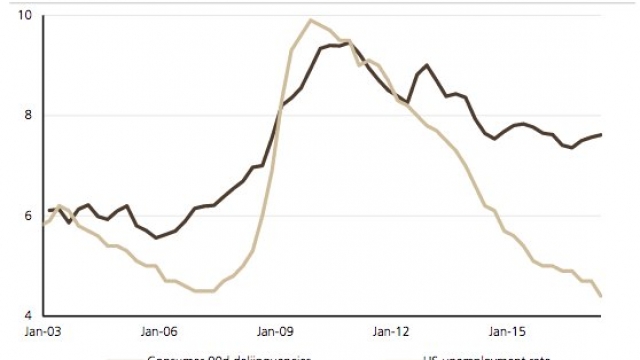
Millennials are being ‘left behind,’ and it poses a huge risk to the US economy
http://ift.tt/2ydfebI
The labor market is improving, and yet consumer
delinquencies are creeping up.
UBS
The unemployment rate dropped to 4.2% in September, its
lowest since February 2001, and yet consumer
loan defaults keep creeping up.
In fact, the divergence between the labor market on one hand, and
consumer credit performance on the other, is at a
record. What figures?
UBS analysts led by Matthew Mish and Stephen Caprio set out
to answer that question, and their findings highlight the
financial difficulties many millennials are facing.
According to Mish and Caprio, there are two cohorts
that have been left behind by the labor market: lower income
households, and millennials.
“The most underappreciated factor explaining consumer stress is
the two-speed recovery in US consumer finances,” they said.
The two strategists dived into the Fed’s latest Survey of
Consumer Finances to calculate a bunch of metrics,
including the the levels of debt to assets and income
across across different age cohorts. Those ratios are near record
levels, with the millennial debt-to-income ratios in line with
2007 levels.
The debt-to-assets ratio for millennials is
soaring
UBS
And that might not tell the whole story. The Fed survey suggests
38% of student loans are not making payment, while the structural
shift from owning a home and paying a mortgage to renting means
that more households are paying rent and making auto lease
payments. In other words, they might have significant outgoings
that aren’t being captured in the debt figures.
“We believe this is particularly problematic when assessing the
financial obligation ratios of US millennials and lower income
consumers,” UBS said.
So what does this mean? Here’s UBS:
“Longer term, the two-tier recovery in consumer finances suggests
key segments of the US population (lower income, millennial
households) are more financially vulnerable than aggregate
consumer credit metrics imply. In turn, these groups will be
more sensitive to fluctuations in labor market conditions and
interest rates ceteris paribus.”
That’s a touch worrying, especially at a time when interest rates
are going up.
For context, millennials hold 18% of debt outstanding, according
to UBS, and make up 19% of annual consumer expenditures.
Together, the two cohorts “left behind,” lower income households
and millennials, make up about 15% to 20% of debt, and 27% to 33%
of expenditure.
So if they’re struggling, it has the potential to negatively
impact the economy pretty significantly.
Millennials make up a big chunk of the consumers citing
a loan default in the next 12 months.
UBS
business
via Business Insider http://ift.tt/eKERsB
